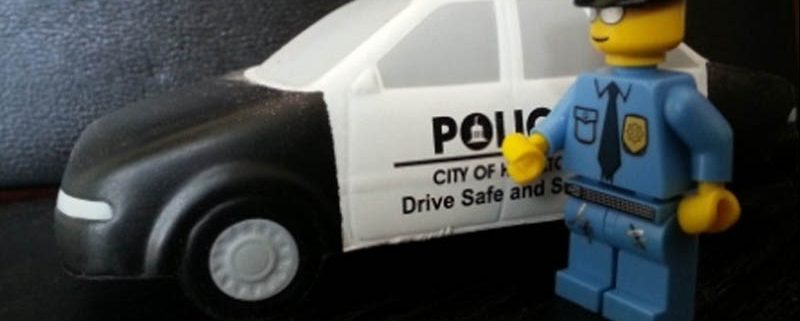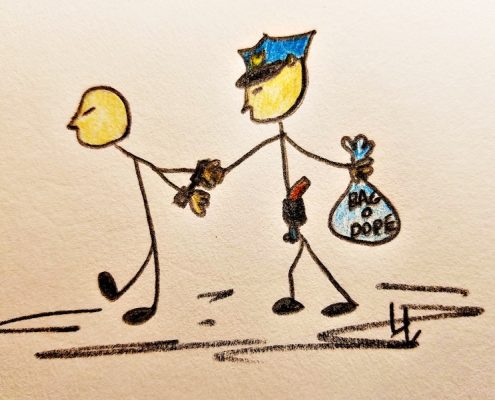A gun is a cop’s silent best friend and, without fail, they’re always there when the officers need them.
They’re extremely low maintenance—a diet of fresh bullets along with a little Hoppes gun oil to wash them down, a bath for the little fella a bath every Saturday night, and don’t let them play in the rain and the dirt. That’s about it.
But pistols can be a touch on the sensitive side, so it’s a must to cradle them gently, never letting them fall to the ground, especially on hard surfaces. And please, you heroes of crime fiction, remember to gently place a hand on their little butts whenever you find yourselves in a dangerous situation. It’s soothes their nerves. Yours too.
That’s all your sidearm will ever ask of you. Nothing more, nothing less. Do these simple things and they’ll remain at your side forever.
Sidearms are Pants-Puller-Downers!
Personally, I liked the feeling of a pistol on my side. Its weight was a comforting reminder that I was not alone, even during the most trying of times. However, the constant downward pull at my belt and waistline could be a bit annoying. Shirt tails riding up on the gun side and pants going in the opposite direction. This is the reason you sometimes see detectives tugging upward at their waistband on their gun side.
And there’s that thing about the hammer insisting that it tear a hole in the lining of every jacket I owned. It was … well, it was pretty darn aggravating. But you get used to it and move on.
Above is the inside of one the jackets I wore while serving as a detective. The patch was sewn over yet another hole worn through the lining caused by the constant rubbing of the hammer of my SIG Sauer against the fabric.
But, a little patch, a needle and thread, and you’re back in business. It’s the least you can do for your little one. I had a department-funded clothing allowance but didn’t want to waste it on a new suit each time a hole appeared in the linings.
A Take-Home Home is a Huge Perk for Officers
A take-home car is another BFF. Detectives and some patrol officers often drive the same cars for so long that the foam seat cushions conforms to the shapes of their individual rear-ends.
Unlike a relationship with the gun, though, cops can get away with talking to their vehicles without anyone thinking they’ve finally stepped over into cop la-la-land. People on the outside of the cars have no idea as to whether or no the officer is speaking into a radio mic, or not.
And let’s not forget the graveyard shift sing-a-longs that help officers remain awake once the magic fall-asleep-it’s-four-o’clock hour rolls around. Or the bullet hole in the front fender that’s a constant reminder that the car “took” the one that was meant for its driver.
Yep, the three of you make a great team—the brains, the brawn, and the … well, there’s no “B” for the car, but it’s definitely an integral part of the trio. You go everywhere together. You’re inseparable. Day-in and day-out you do everything together. And it’s your two partners who’re there for you when you’re up and when you’re down. They’re around during the tough times, through fights, saving lives, weddings and divorces. Through good days and through sicknesses. When you held the kid whose mother had just died in a car crash. And when you comforted the parents whose son took the overdose. When you sat behind the wheel and wept because you couldn’t reach far enough inside the burning car to pull the crying infant from the flames.
For twenty-five years, the three of you sacrificed everything to work in the rain, snow, and unbearable heat. You put in grueling, long hours. You worked with injured body parts and during times when family members were dying. And you did it all for low pay and little recognition for your hard work.
All Good and Bad Things Must Come to an End
And then the day finally comes … the day when the three of you are no more.
You drive to work and park, not in your old space, the one you’ve parked in for years, but alongside a row of fleet cars … strangers.
You walk inside for the last time and hand in your keys. Then it’s time to slip off the holster. The instant weight loss feels horrible. Sliding the badge across the desk is worse. But you know the three of you have too many miles behind you to keep going. It’s time to say goodbye.
After all, there’s always a fish to catch or a burger to flip. A mall to guard and shoplifters to nab. Flowers to plant and birdhouses to build. And let’s not forget those customers who need greeting. Besides, that little blue vest is downright sporty, dontcha’ think?






